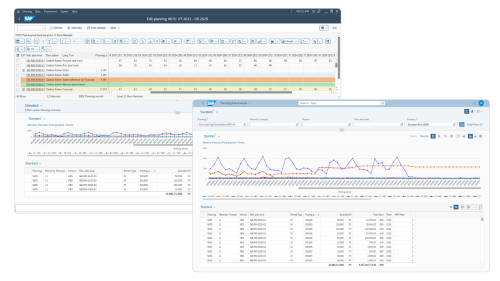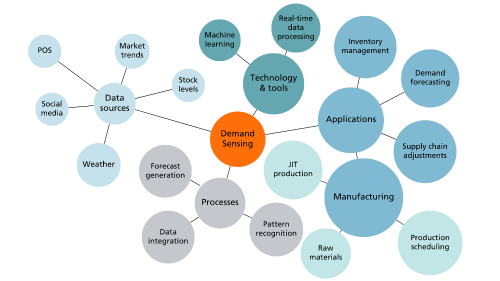Demand Planning Highlights
Fiori App: Planning Data Analysis
Planning Data Analysis simplifies how you view and use your business data. It brings together all your key information—like inventory and schedules—into one Fiori app. This allows you to make quick, informed decisions that keep your operations smooth and efficient. The app also lets you customize how you analyze your data, provides quick links to related operational insights, and includes currency conversion, making it perfect for global businesses.

Key features and capabilities
- Comprehensive data collection: The app uses essential data from key planning tables like /GIB/DCF_PLANG and /GIB/DCF_PLANS.
- Customizable data visualization: Choose from a variety of diagrams and key performance indicators (KPIs) to tailor data presentation to your needs.
- Advanced grid layout: Detailed grid view allows for custom layouts and grouping by specific periods or material groups for targeted analysis.
- Seamless navigation tools: Directly access your planning sheet, Live Stock Analysis, or Operations from any data point.
- Flexible currency conversion: Easily convert total values to different currencies, perfect for global operations.
- Consistent valuation methods: Uses the same valuation approach as found in the planning sheet to ensure accuracy and consistency.
- Enhanced planning sheet integration: Analyze data and execute relevant tasks seamlessly by accessing the app directly within the planning sheet.
Demand sensing
Demand sensing utilizes machine learning and real-time data to improve short-term demand forecasting. Within ifm's software, this involves setting up daily planning scenarios that work alongside monthly planning. The system compares current sales data against forecasted data for the month, indicating whether actual sales are significantly over or under the forecast. By incorporating recent sales trends and adjusting forecasts accordingly, demand sensing enables businesses to respond quickly to changes in demand, reducing the risk of stockouts or overstock situations. This approach helps maintain inventory levels that better align with actual customer demand, ensuring more efficient and responsive supply chain management.

Key features
- Machine learning algorithms: Demand sensing utilizes sophisticated analytics tools and machine learning algorithms to process and interpret the vast amounts of data. These tools identify patterns and trends that are not immediately obvious, enabling more accurate and timely forecasts.
- Real-time data integration: It integrates data from diverse sources, including point-of-sale (POS) systems, market trends, weather forecasts, and social media. This real-time data collection is fundamental to providing up-to-date insights into consumer demand.
- Integration with supply chain operations: Demand sensing is closely integrated with other supply chain systems, such as inventory management and production planning, allowing for a coordinated response to demand signals.
- Short-term focus: Unlike traditional forecasting that looks weeks or months into the future, demand sensing focuses on the immediate term, typically the next few days to weeks. This allows businesses to respond quickly to changes in demand.
- Continuous learning and adaptation: The system continuously learns from the data it processes, which means its predictions become more accurate over time. It adapts to new trends, seasonal variations, and changes in consumer behavior.
More Demand Planning features
| Automatic Excel Template Generator | Requirement Segmentation | Quality of Planning Forecast (QOPF) & Forecast LAGS |
| Streamline data uploads with auto-generated templates | Categorize each customer segment based on specific criteria | Analyze detailed forecast changes and accuracy improvements |
| Custom Formula Configuration | Dynamic Aggregation | Enhanced MRP Area Configuration |
| Enable dynamic updates through formulas | Aggregate product hierarchy levels and analyze planning data dynamically | Integrate comprehensive MRP area details |
Ready to upgrade?
If you have any questions or would like to see a demo of specific demand planning features or enhancements, fill out the form below.